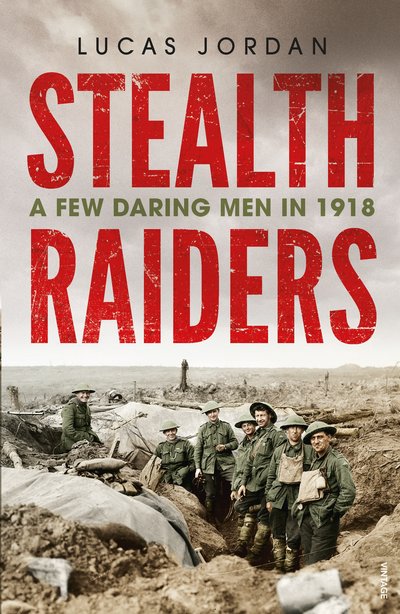Thoughts of the First World War typically conjure images of deep muddy trenches, barbed wire and craters; yet during the summer of 1918 after the German Spring offensive had culminated, battles were fought on rolling farmlands.This landscape and its vegetation, coupled with fronts comprising outposts rather than trench-lines, afforded the opportunity for a few daring men to voluntarily undertake raids to capture prisoners, equipment and terrain, utilising no more than small arms, initiative and cunning. Charles Bean described these actions in the Official History as ‘peaceful penetration’. But given that most involved a degree of violence, Jordan has opted for a term used by the soldiers who undertook these actions – ‘stealth raids’.

Ursula Davidson Library call number 572 JORD 2017
Frustrated with large formal engagements that often lost the element of surprise and resulted in heavy casualties, a few daring low-ranking Australian infantrymen undertook unauthorised raids that took little time to plan and execute and were overwhelmingly more effective. These stealth raiders killed Germans, captured prisoners and advanced the line, sometimes by thousands of yards. They were held in high regard by other men of the lower ranks, and were feared by the Germans facing them.
For example, on 18 May 1918, a small group of Australian soldiers in a post on the Somme sensed that the Germans manning a machine gun post 90 yards away were asleep. Eighteen stealth raiders promptly jogged across the dead ground in No Man’s Land and leapt into the German post. They captured 22 Germans and the machine gun. The sortie took 10 minutes to plan and seven minutes to execute. It was so swift and silent that Germans in a nearby trench had no idea their machine gun had been captured.
This book extensively examines the raids and their success. It makes the point that sometimes the raids removed the need for a deliberate formal attack. It shows that Australian stealth raids were the inspiration for similar ventures by New Zealand and British units.
The participants were skilled veteran soldiers, often of low rank and, more frequently than averages would indicate, hailed from the Australian bush. The distinct ‘bush’ ethos, with its high emphasis on independence, initiative and mateship, and skills acquired in the bush, meant these men were uniquely suited to these forays.
Of 1918, Charles Bean wrote: “All of us knew of instances — I personally found them to occur more often than not — in which the commander’s report on an action contained important inaccuracies. Commanding officers, for example, constantly — and naturally — believed and reported that some movement made by their troops was the result of an order issued by them, when it had actually been initiated and carried out by a company commander or one of his men on the spot before the order from above arrived — if ever it did.” Such a case was the capture of Chipilly Spur during the Allied August offensive. Monash claimed that Chipilly Spur was captured on his orders by an Australian brigade and the American 131st Regiment, after a British division had failed to take it. But the spur was actually captured by six Australians — two non-commissioned officers and four privates, using stealth raid tactics. Its capture on 9 August 1918 was the decisive moment of that battle. These types of actions are the crux of the book.
We often see books promoted as “the untold story”, but in this instance the claim is quite true. Stealth Raiders is an original work based on a large amount of research. Because such raids were rarely, if ever, referred to in formal written orders, the facts could only be ascertained from soldiers’ diaries and letters. First-hand accounts can be prone to exaggeration, but Jordan overcomes this obstacle by the sheer number of records examined and careful cross-referencing with official records.
Lucas Jordan is a history teacher and Stealth Raiders is his first book. It has been adapted from his PhD thesis, supervised by historians Professor Bill Gammage (Australian National University) and Dr Peter Stanley (University of New South Wales).
Stealth Raiders includes 16 pages of images, comprehensive end notes, short biographical details on all the soldiers mentioned in the text, as well as a bibliography and index.
A comprehensive and vivid exploration of the audacious, unauthorised and stealthy attacks by seasoned infantrymen on the front line, Stealth Raiders showcases the ingenuity of diggers of the Australian Imperial Force at the peak of their powers and is highly recommended.
Contact Marcus Fielding about this article.






